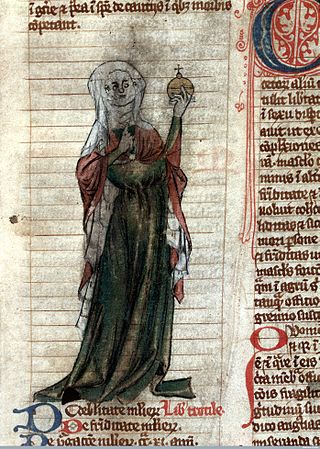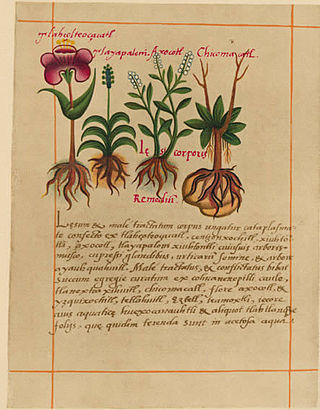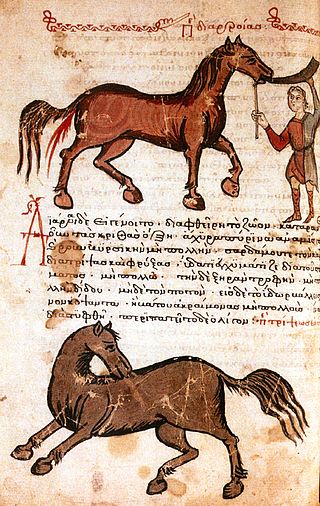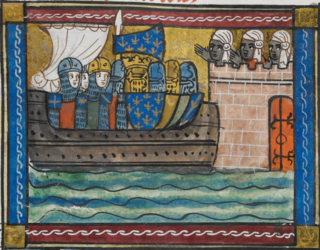
The Physiologus is a didactic Christian text written or compiled in Greek by an unknown author in Alexandria. Its composition has been traditionally dated to the 2nd century AD by readers who saw parallels with writings of Clement of Alexandria, who is asserted to have known the text, though Alan Scott has made a case for a date at the end of the 3rd or in the 4th century. The Physiologus consists of descriptions of animals, birds, and fantastic creatures, sometimes stones and plants, provided with moral content. Each animal is described, and an anecdote follows, from which the moral and symbolic qualities of the animal are derived. Manuscripts are often, but not always, given illustrations, often lavish.

The Vulgate, sometimes referred to as the Latin Vulgate, is a late-4th-century Latin translation of the Bible.

In Greek mythology, Chiron was held to be the superlative centaur amongst his brethren since he was called the "wisest and justest of all the centaurs".
Diogenes Laërtius was a biographer of the Greek philosophers. Little is definitively known about his life, but his surviving Lives and Opinions of Eminent Philosophers is a principal source for the history of ancient Greek philosophy. His reputation is controversial among scholars because he often repeats information from his sources without critically evaluating it. He also frequently focuses on trivial or insignificant details of his subjects' lives while ignoring important details of their philosophical teachings and he sometimes fails to distinguish between earlier and later teachings of specific philosophical schools. However, unlike many other ancient secondary sources, Diogenes Laërtius generally reports philosophical teachings without attempting to reinterpret or expand on them, which means his accounts are often closer to the primary sources. Due to the loss of so many of the primary sources on which Diogenes relied, his work has become the foremost surviving source on the history of Greek philosophy.

PubliusVegetius Renatus, known as Vegetius, was a writer of the Later Roman Empire. Nothing is known of his life or station beyond what is contained in his two surviving works: Epitoma rei militaris, and the lesser-known Digesta Artis Mulomedicinae, a guide to veterinary medicine. He identifies himself in the opening of his work Epitoma rei militaris as a Christian.

De re militari, also Epitoma rei militaris, is a treatise by the Late Latin writer Publius Flavius Vegetius Renatus about Roman warfare and military principles as a presentation of the methods and practices in use during the height of the Roman Empire and responsible for its power. The extant text dates to the 5th century.

Gaius Julius Phaedrus, or Phaeder was a 1st-century AD Roman fabulist and the first versifier of a collection of Aesop's fables into Latin. Nothing is recorded of his life except for what can be inferred from his poems, and there was little mention of his work during late antiquity. It was not until the discovery of a few imperfect manuscripts during and following the Renaissance that his importance emerged, both as an author and in the transmission of the fables.

Trotula is a name referring to a group of three texts on women's medicine that were composed in the southern Italian port town of Salerno in the 12th century. The name derives from a historic female figure, Trota of Salerno, a physician and medical writer who was associated with one of the three texts. However, "Trotula" came to be understood as a real person in the Middle Ages and because the so-called Trotula texts circulated widely throughout medieval Europe, from Spain to Poland, and Sicily to Ireland, "Trotula" has historic importance in "her" own right.

The Travels of Sir John Mandeville, commonly known as Mandeville's Travels, is a book written between 1357 and 1371 that purports to be the travel memoir of an Englishman named Sir John Mandeville across the Islamic world as far as India and China. The earliest-surviving text is in French, followed by translations into many other languages; the work acquired extraordinary popularity. Despite the extremely unreliable and often fantastical nature of the travels it describes, it was used as a work of reference: Christopher Columbus, for example, was heavily influenced by both this work and Marco Polo's earlier Travels.

The Emerald Tablet, the Smaragdine Table, or the Tabula Smaragdina is compact and cryptic Hermetic text. It was a highly regarded foundational text for many Islamic and European alchemists. Though attributed to the legendary Hellenistic figure Hermes Trismegistus, the text of the Emerald Tablet first appears in a number of early medieval Arabic sources, the oldest of which dates to the late eighth or early ninth century. It was translated into Latin several times in the twelfth and thirteenth centuries. Numerous interpretations and commentaries followed.

The Codex Amiatinus is considered the best-preserved manuscript of the Latin Vulgate version of the Christian Bible. It was produced around 700 in the northeast of England, at the Benedictine Monkwearmouth–Jarrow Abbey in the Kingdom of Northumbria, now South Tyneside, and taken to Italy as a gift for Pope Gregory II in 716. It was one of three giant single-volume Bibles then made at Monkwearmouth–Jarrow, and is the earliest complete one-volume Latin Bible to survive, only the León palimpsest being older. It is the oldest Bible where all the biblical canon present what would be their Vulgate texts.

The Libellus de Medicinalibus Indorum Herbis is an Aztec herbal manuscript, describing the medicinal properties of various plants used by the Aztecs. It was translated into Latin by Juan Badiano, from a Nahuatl original composed in the Colegio de Santa Cruz de Tlatelolco in 1552 by Martín de la Cruz that is no longer extant. The Libellus is also known as the Badianus Manuscript, after the translator; the Codex de la Cruz-Badiano, after both the original author and translator; and the Codex Barberini, after Cardinal Francesco Barberini, who had possession of the manuscript in the early 17th century.

The Chronicle of 754 is a Latin-language history in 95 sections, written by an anonymous Mozarab (Christian) chronicler in Al-Andalus. The Chronicle contains the earliest known reference in a Latin text to "Europeans" (europenses), whom it describes as having defeated the Saracens at the battle of Tours in 732.
The so-called Vatican Mythographers are the anonymous authors of three Latin mythographical texts found together in a single medieval manuscript, Vatican Reg. lat. 1401. The name is that used by Angelo Mai when he published the first edition of the works in 1831. The text of the First Vatican Mythographer is found only in the Vatican manuscript; the second and third texts are found separately in other manuscripts, leading scholars to refer to a Second Vatican Mythographer and a Third Vatican Mythographer.
The Vita tripartita Sancti Patricii is a bilingual Life of Patrick, written partly in Irish and in parts in Latin. It is a hagiography focusing on Patrick. The text is difficult to date. Kathleen Mulchrone had assigned a late ninth century date based on the latest historical reference in the text. However, on linguistic grounds, it has been dated to as late as the twelfth century. The text as it stands probably reflects various stages of development. Máire Herbert summarises:
While there are some textual references indicative of ninth-century date, in my opinion the text was continued thereafter and completed around or after the mid-tenth century. Some decades later, in the eleventh century, the text was edited as a tripartite homily designed for preaching during celebration of the saint's feast.
The Collationes in Hexaemeron are an unfinished series of theological lectures given by St. Bonaventure in Paris between Easter and Pentecost 1273.
The Liber de compositione alchemiae, also known as the Testamentum Morieni, the Morienus, or by its Arabic title Masāʾil Khālid li-Maryānus al-rāhib, is a work on alchemy falsely attributed to the Umayyad prince Khalid ibn Yazid. It is generally considered to be the first Latin translation of an Arabic work on alchemy into Latin, completed on 11 February 1144 by the English Arabist Robert of Chester.

The Hippiatrica is a Byzantine compilation of ancient Greek texts, mainly excerpts, dedicated to the care and healing of the horse. The texts were probably compiled in the fifth or sixth century AD by an unknown editor. Currently, the compilation is preserved in five recensions in 22 manuscripts ranging in date from the 10th to the 16th centuries AD.
Amable Jourdain was an early 19th-century French historian and orientalist, a student of Louis-Mathieu Langlès and Antoine-Isaac Silvestre de Sacy, a specialist of ancient Persia and the Latin transmission of Aristotle.

The Directorium ad faciendum passagium transmarinum is an anonymous 24,000-word Latin treatise on crusading submitted to King Philip VI of France on 26 July 1330 or 1332. The treatise proposes the conquest of the Holy Land, the Byzantine Empire and Russia and their subjection to the Catholic Church; outlines how this might be achieved; and describes how the conquered territories could be administered.












